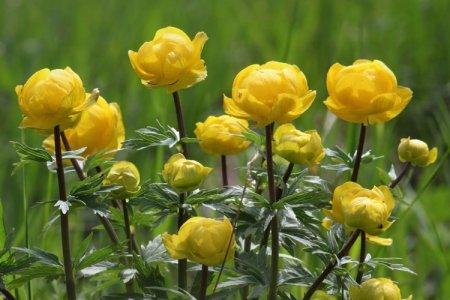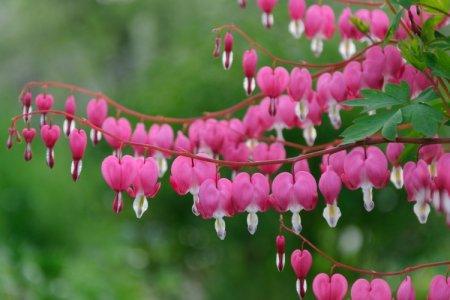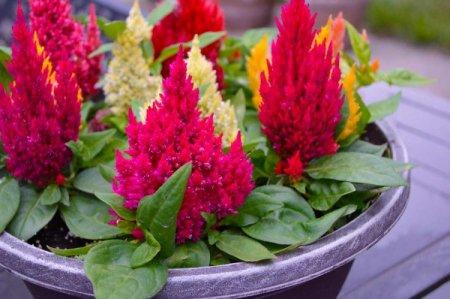
Among tropical guests who feel great in the gardens, Helichrisum has taken a special place. He is also called immortelle and tsmin. This is a spectacular fall plant loved by landscape designers and traditional medicine aficionados!
general information
In nature, helihrizum is common in Australia and Africa. Like most other flowers with a characteristic inflorescence basket, it belongs to the Astera. There are annuals and perennial varieties, but the former are more common in our latitudes.
Gelichrizum has a tall, branched stem up to 1.2 m high. But there are also completely dwarf species - 30-40 cm each, no more. Lanceolate leaves and shoots are slightly pubescent, and the diameter of the inflorescences reaches 7 cm.
The most common shades are yellow and red, but this is not the limit. Interestingly, even during flowering, the petals of gelichrizum seem a little dry. That is why wonderful dried flowers for needlework and decor are obtained from them.

Types of gelichrizum
The types of gelichrizum are very diverse. They can be classified by size - from dwarf to true giants, and also by type of flower.
Bracts gelichrisum
This is a perennial that is grown in our latitudes as an annual plant. Monophonic tall varieties with inflorescences up to 6 cm in diameter are very popular.

Daisy flower gelichrizum
Its flowers resemble daisies, and the green carpet blooms in June. A small bush up to 8 cm in height is capable of growing in width up to all 50 cm.

Awl-leaved gelichrisum
The dwarf garden annual adorns lawns and creates whole flowering carpets. It is an excellent groundcover with yellow, non-double flowers.

Narrow-leaved gelichrizum
It is easy to recognize not only by its narrow leaves, but also by the silvery shade of the shoots. This is a beautiful curb plant up to 30 cm high.

Coral-shaped helihrizum
The best option for decorating rock gardens and rockeries. Thin short twigs up to 25 cm covered with small grayish leaves and yellow or white inflorescences.

Great Helichrizum
In fact, this is a large-flowered form of the common bracts gelichrisum. As you might guess, it is distinguished by large and showy decorative buds.

Gelikhrizum Selago
The compact creeping shrub with white baskets looks somewhat different from its counterparts. And its dark green leaves appear velvety due to their structure and shade.

Petiolate gelichrizum
It can be recognized by the silvery pubescence of the creeping shoots and heart-shaped leaves. This species needs more intensive watering and feeding, because it tolerates drought worse.

Milf Gelichrizum
A tiny but very beautiful plant with delicate two-colored petals. Outside, they are bright pink, and inside they are snow-white. Milf-shaped gelichrizum blooms from late spring to autumn.

Ampel gelichrizum
This type is used for landscaping verandas, terraces, balconies and other structures. It is especially good in hanging pots, in which it grows into a dense and abundantly flowering bush.

Helmet Helichrizum
The very tiny species grows hardly up to 30 cm. It has a very graceful flower shape and a pleasant delicate shade of pink with a yellow center.

Terry gelichrizum
This category most often includes breeding varieties and hybrids. So, in addition to decorative flowering, they can also boast of increased unpretentiousness and resistance to different conditions.

Sandy gelikhrizum
Not the brightest, but one of the most persistent species. It grows to only 10 cm, blooms until frost and is densely covered with small yellow buds.

Gelichrizum care
This is a completely unpretentious and hardy flower. Even beginners can easily achieve lush flowering.The main thing is to choose the right place and periodically feed the planting!
Temperature and lighting
Despite the fact that it is an African flower, it tolerates short frosts well. At the same time, Gelichrizum is drought tolerant and prefers warm, sunny areas.

Watering
On hot summer days, gelichrizum is best watered systematically on schedule. But remember that it tolerates drought better than waterlogging, so it is better to underfill than overflow.

The soil
Gelikhrizum loves light and nutritious soils. In nature, it grows on a rather scarce soil, but in such conditions it is much less decorative. Be sure to provide good drainage so that water does not stagnate at the roots.

Fertilizers and feeding
To make gelichrizum bloom more actively, it is fed every 2-3 weeks. Complex fertilizers for flowering or ordinary compost are suitable. Add the first portion during planting, and then repeat the procedure at the specified interval.

Cut
Cut varieties are cut at the very beginning of flowering. After that, in tall varieties, you need to pinch the main shoot over about 5 leaves. The cut flowers are collected in bunches and dried.

Wintering
Gelikhrizum freezes out when the temperature drops below -20 degrees, and that is why it is grown here as an annual. But in the south of Russia, it can overwinter in the ground with a fairly dry winter under a carpet of sawdust and leaves. In addition, several pieces can be transplanted into pots and brought into the room.

Planting and reproduction of gelichrizum
Annuals are propagated by seed in March, and it is best to do this through seedlings. Seeds are buried in holes, several pieces in a mixture of peat and sand, and left under a film. Periodically they need to be sprayed, and after 2 weeks the seedlings can be safely dived. The grown plants are planted in the garden when the threat of frost has passed. There should be a distance of about 16 cm between them.
Seeds are sown into the ground according to the same scheme, but at the end of April, and they are also kept under a film to a stable +15 degrees. Leave a distance of 10-12 cm between the holes in order to thin out the seedlings less later. But such gelichrisum will bloom later, by August.
Perennials are propagated by dividing the bush in the spring. Gelichrizum easily survives transplants and quickly adapts to a new place, so there will be no problems with this. And at the height of summer, cuttings can be rooted in a mixture of peat and sand. It is better to do this under a film until the seedling gets stronger.

Pest and disease control
Helichrisum almost does not suffer from diseases if the irrigation regime is observed and the soil is not waterlogged. The only common problem is leaf rust, but ordinary Bordeaux fluid helps. But pests are very fond of this plant, so we advise you not to neglect the planned treatment with insecticides.

Gelikhrizum - photo
Gelikhrizum is grown not only for cutting, but also for decorating flower beds or borders. Fortunately, you can always choose a suitable variety of the desired size and shade!



























